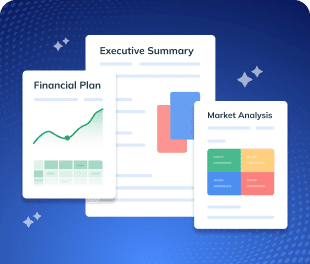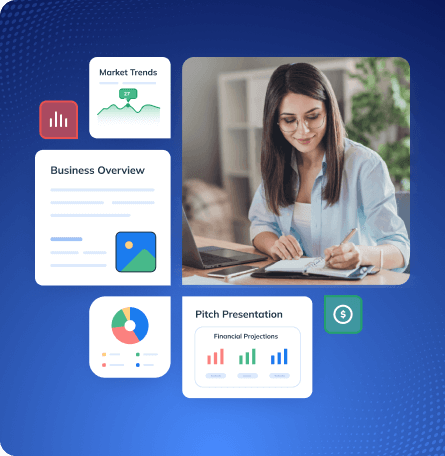Ever thought about opening your own retail store but felt stuck with too many questions—What should I sell? Where should I open? How do I handle money, stock, and customers without getting overwhelmed?
Well, these are common struggles, and without a clear plan, they can easily stop your dream from moving forward.
That’s why we made this template—to help you turn your ideas into a simple, step-by-step plan for your goals, products, budget, and marketing.
Download this free retail store business plan template to start building your store with confidence.
Keep reading to see how to use it and create a plan that sets your store up for success.
What is a retail store business plan?
A retail store business plan is a comprehensive document outlining a store’s goals, strategies, and financial projections. It serves as a roadmap for guiding daily operations and making informed decisions about products, pricing, staffing, and marketing.
A well-structured plan helps ensure the business is focused, organized, and aligned with its objectives for long-term success.
How to write a detailed retail store business plan?
When writing a business plan for your retail store, it’s important to focus on the key parts that clearly share your vision and how you plan to succeed.
Here’s a simple guide to help you build a detailed retail store business plan:
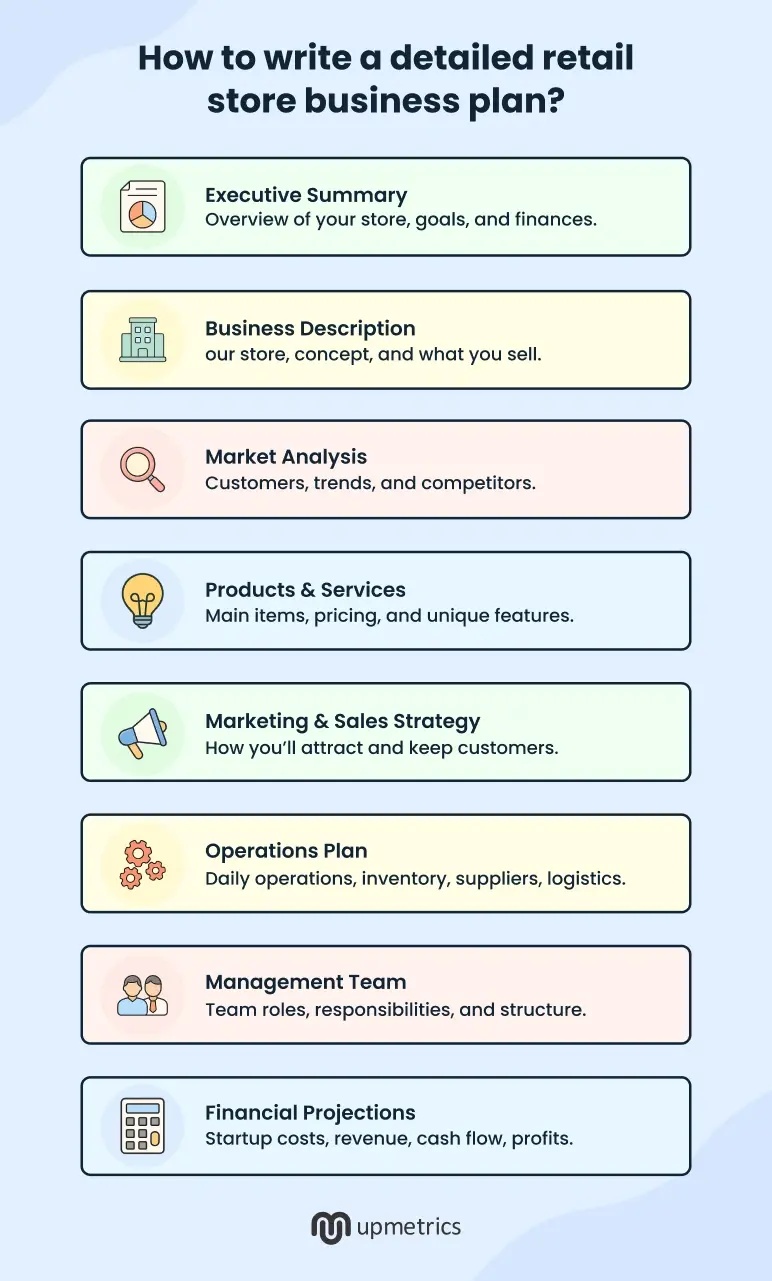
1. Executive Summary
The executive summary is a short and clear introduction to your retail store. It gives people the main idea before they read the full plan—like telling the “short story” of your business.
It’s best to write this part after you finish the rest of your plan so you can include the most important points. Keep it short—about one or two pages—and make it interesting so readers want to learn more.
While planning this section, consider answering:
- What is your store’s name, and where is it? Why did you choose that spot?
- Why is now a good time to open? Are people in your area looking for your products?
- What will you sell? What makes your store special?
- How will you get customers and increase sales? Will you sell in the store, online, or both?
- How much do you hope to earn in the first year? Do you need money to start or grow?
Overall, this part should quickly explain what your store does and why it can succeed. Keep the language simple and confident so people feel excited about your business.
Say goodbye to boring templates
Build your business plan faster and easier with AI
Plans starting from $14/month

2. Business Description
The business description section gives more details about your retail store. In this part, you explain the basics and help people understand what your store is all about.
Here’s what you need to include in this section:
Business name and location
Start by introducing your store’s name and where it operates. Mention whether it’s based in a busy shopping street, inside a mall, or in a local neighborhood.
Business structure and type
Say if you run the store alone, with a partner, or as a registered company like an LLC. Also, explain what type of retail store it is—for example, a clothing store, grocery store, electronics shop, or home décor store.
Mission and vision
Write a short line about what your store wants to do. Example: “To sell good quality products at fair prices with friendly service in a welcoming place.”
Then share your vision statement, like becoming the most trusted and popular store in your area.
Company background
If you’ve already been selling products—online, at markets, or from a small shop—mention it. Also, share if you have retail or business experience.
Goals
Add your short-term goals, like attracting first regular customers, setting up a store website, or creating a loyal customer base. And long-term goals like opening more branches or expanding product categories.
Keep this section clear and interesting so readers understand exactly what your retail store does and who you are.
3. Market Analysis
This section shows you understand the retail market, your customers, and your competition. It also proves there’s demand for your store.
Start by explaining the retail market in your area. Is it growing? Are more people shopping locally or online? You can also include industry-specific data or facts, like:
“The global retail market is valued at $27.26 trillion in 2025 and is projected to reach $36.91 trillion by 2030.”
You can even back this up with visuals. For example, the chart below shows the retail industry’s market share by product type in 2024, with food, beverage, and grocery making up 47.8% and personal and household care products at 52.2%.
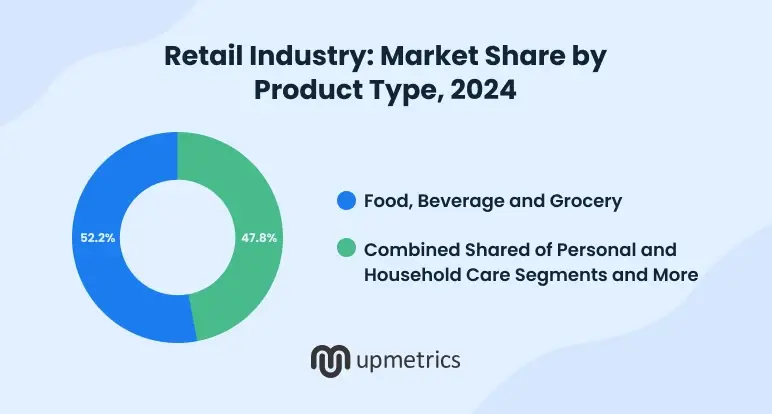
Sharing data like this helps your readers quickly understand where your store fits in the market and which product categories have room to grow.
Next, describe your target customers. Who will shop at your store? Families, young adults, working professionals, or bargain hunters? Think about their age, income, and shopping habits.
Talk about the market trends that can help your store grow, such as:
- People like stores that also sell online.
- Shoppers want unique products they can’t find in big chain stores.
- Good customer service and a friendly atmosphere bring customers back.
After that, look at your competition.
Direct competitors, like other local shops selling similar products.
Indirect competitors, for example, online sellers, supermarkets, or malls that might attract the same customers.
Explain what they do well, where they lack, and how your store will be different—such as better prices, exclusive items, or a more personal shopping experience.
Finally, mention any rules or permits you need to run your store.
By the end, readers should see that you know your market and have a clear plan to succeed.
4. Products and Services Offerings
The products and services section explains what your retail store will offer. It shows how you plan to earn money while meeting your customers’ needs.
While planning, try to break this section into below categories:
Product categories
Write about the types of products your store will have. Be clear about your main items and any special products that make you different.
Here’s an example of different store types and what they might offer:
| Store Type | Products | Services |
|---|---|---|
| Boutique | Clothes, shoes, bags, accessories | Personal styling, gift wrapping |
| Small grocery | Fresh produce, packaged foods, household basics | Home delivery, bulk ordering |
| Craft shop | Art supplies, craft kits, DIY materials | Workshops, custom orders |
| Small electronics store | Phones, gadgets, accessories, small appliances | Repairs, tech setup help |
Pricing
Keep your pricing clear and easy to understand. You may choose to set standard prices for each product category, offer seasonal sales, or give discounts for bulk purchases.
If you offer services, explain how you charge for them. For custom products or services, you can provide pricing based on the specific request.
Value to customer
Your product selection should give customers a reason to choose your store over others. This could be:
- Offering products that are hard to find locally
- Providing higher-quality items than competitors
- Selling at better prices or with more variety
- Creating a more personal and friendly shopping experience
Quality
Explain how you’ll make sure products are high quality and services are consistent. This could include:
- Checking supplier quality before purchase
- Storing products in the right conditions
- Training staff to give excellent customer service
- Getting regular feedback from customers
Future plans
If you plan to expand your offerings later, such as adding new product lines, seasonal collections, or extra services, mention these here. For example, a boutique could add a shoe section, or a grocery store could introduce ready-to-eat meals.
By the end of this section, people should know exactly what your store sells, how it helps customers, and why they should choose your store over others.
5. Marketing and Sales Strategy
To run your store well, you need to tell people about your products and why they should buy from you. You can’t just wait for customers—you have to show them why your store is good.
You can break down this section into categories:
Marketing Strategies
Discuss how you plan to reach your target customers and attract them to your store and products. Here are some methods you may consider:
- Make a simple website and share pictures of your products on Facebook and Instagram.
- Put your store on Google Maps so people nearby can find you.
- Run ads online to reach more customers.
- Work with other local businesses to tell their customers about your store.
- Join local events or markets to meet new customers.
- Give discounts to new customers to bring them in.
Sales Strategies
Explain how you’ll convert interested visitors into paying customers. For that, you can:
- Help customers when they come to your store.
- Show them your best products and answer their questions.
- Tell them the prices clearly and explain any deals.
- Follow up if they look interested but don’t buy right away.
- Offer different choices so they can pick what fits their budget.
Overall, this section shows you have a plan to attract, build trust, and sell more products.
6. Operations Plan
The operations plan explains how your retail store will work every day. It shows potential investors or lenders that you know what to do to keep the store running well.
Here are the important points for your retail store operations plan:
Location & setup
Mention where your store is located—like a busy street, shopping mall, or market. Say why this place is good for your store, like many customers visit, or it’s easy to get there.
Equipment & tools
List the important equipment you’ll use, like shelves, cash registers, computers, and barcode scanners. Also, mention any software for managing sales or inventory.
Daily operations
Describe the regular tasks you’ll do every day, such as:
- Open and close the store
- Help customers
- Put products on shelves
- Take payments
- Clean and keep the store neat
Suppliers & partners
Mention who will supply your products and how often you’ll order from them. Also include any delivery services or other partners who help run the store.
Team & staff
Who will work in the store daily? Describe the roles, like cashier, sales assistant, or manager. Mention if you plan to hire more people as the business grows.
By covering these points, you show investors or partners that your retail store is set up to run well, serve customers, and grow over time.
7. Management Team
The management team section explains who is running the retail store and how their skills will help it succeed.
Start with yourself. If you’re the owner, write a short intro—like your past experience in retail, sales, customer service, or business management.
If you have other team members, like a store manager, sales staff, cashier, or marketing person, mention them. Say what they do, their skills, and their experience.
Here’s an example you can use as a reference while presenting your management team’s roles, skills, and experience:
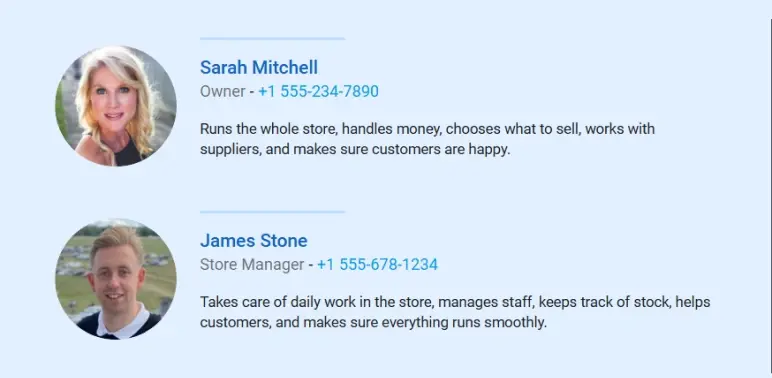
Keep in mind that the team can vary depending on the type and size of the store.
You can also add a simple organizational chart to show who reports to whom.
If you have mentors, retail experts, or business advisors supporting you, include them too. It shows you have guidance and makes your plan stronger.
In short, this section helps readers see that your team can run the retail store successfully.
8. Financial Projections
This part shows the financial side of your retail store plan. It helps you see if your store can make enough money and how it will do over the next few years.
Here’s how to make your financial plan:
Startup Costs and Funding Needs
Start by listing all the money you need to open your store, such as:
- Buying products to sell
- Rent and security deposit for the store
- Store setup costs (shelves, signs, cash register)
- Marketing and advertising
- Licenses or permits
Say how you’ll pay for these costs—from your savings, a loan, or investors. If you want a loan or investment, say how much you need and any important details.
How You’ll Make Money
Explain how your store will earn money. Usually, this is from selling products to customers. You can give an estimate of how many sales you expect and at what price, for the next 3 to 5 years.
Expenses
List your regular costs:
- Fixed costs: rent, staff salaries, electricity, insurance, and loan payments
- Variable costs: buying new products to sell, packaging, transaction fees
Financial Statements
Include these reports to show your store’s financial health:
Profit & loss statement
| Income and Expenses | Amount (USD) |
|---|---|
| Income (Sales Revenue) | $150,000 |
| Cost of Goods Sold (inventory) | $90,000 |
| Gross Profit | $60,000 |
| Operating Expenses | |
| Rent | $18,000 |
| Utilities | $3,600 |
| Salaries (staff) | $24,000 |
| Marketing | $5,000 |
| Insurance | $1,200 |
| Miscellaneous | $1,200 |
| Total Operating Expenses | $53,000 |
| Net Profit Before Tax | $7,000 |
Cash flow statement
| Cash Flow Activity | Amount (USD) |
|---|---|
| Cash Inflows | |
| Sales Revenue (cash received) | $140,000 |
| Loan Received | $20,000 |
| Total Cash Inflows | $160,000 |
| Cash Outflows | |
| Inventory Purchases | $85,000 |
| Rent | $18,000 |
| Utilities | $3,600 |
| Salaries | $24,000 |
| Marketing | $5,000 |
| Loan Repayments | $5,000 |
| Other Expenses | $2,400 |
| Total Cash Outflows | $143,000 |
| Net Cash Flow | $17,000 |
| Opening Cash Balance | $5,000 |
| Closing Cash Balance | $22,000 |
Balance sheet
| Category | Amount (USD) |
|---|---|
| Current Assets | |
| Cash | $22,000 |
| Inventory | $30,000 |
| Accounts Receivable | $8,000 |
| Total Current Assets | $60,000 |
| Current Liabilities | |
| Short-term Loans | $10,000 |
| Accounts Payable | $5,000 |
| Total Current Liabilities | $15,000 |
| Owner’s Equity | |
| Owner’s Capital | $40,000 |
| Retained Earnings | $13,000 |
| Total Equity | $53,000 |
| Total Liabilities + Equity | $68,000 |
Use these to find your break-even point—how many sales you need to cover all your costs.
These help people understand your financial story quickly.
Financial Assumptions
List important guesses you made to create these numbers, like:
- Expecting to sell 200 items per month by Year 2
- Assuming product costs will rise by 5% each year
This helps make your plan clear and easier to update if things change.
Return on Investment
If you borrow money or get investors, say when you expect to pay them back or make a profit. Explain how their money helps your store grow.
With realistic financial projections, you show that your retail store is not just a good idea but also a smart business financially.
Key considerations for a retail store
Before finishing your business plan, think about these important things. They help your store do well:
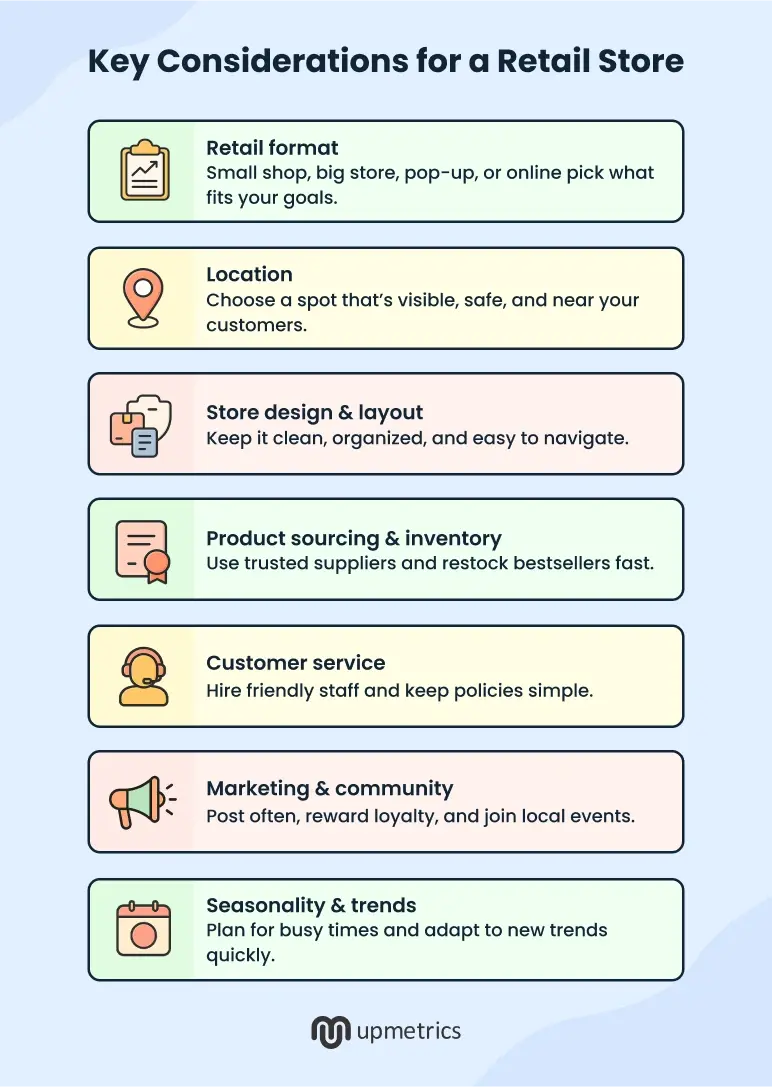
- Retail format: Pick what kind of store you want (small shop, big store, temporary store, or online).
- Location: Choose a place that is easy to find, safe, and good for customers. Look for spots with lots of people walking by, parking close, and other stores with similar customers.
- Store design & layout: Keep your store clean and organized. Use signs and put things where customers can find them easily.
- Product sourcing & inventory: Work with suppliers you trust. Keep track of what sells and buy more before it runs out.
- Customer service: Friendly staff help your store. Teach them about products and how to help customers. Make return and exchange rules simple.
- Marketing & community: Post on social media often, give rewards to loyal customers, and ask for reviews. Join local events or work with other stores to get more customers.
- Seasonality & trends: Get ready for busy times like holidays or back-to-school. Watch for new trends and be ready to change your products fast.
Download a sample retail store business plan
Ready to start writing your retail store business plan from scratch? But not sure how to begin? Don’t worry; we’ve got you covered! Simply download our free retail store business plan PDF to get a head start.
This modern, investor-ready template is designed for aspiring retail store owners to build their plans quickly and efficiently. It includes step-by-step instructions and pre-filled examples for inspiration and guidance. You can even easily edit and format your plan and export it in multiple formats.
The Quickest Way to turn a Business Idea into a Business Plan
Fill-in-the-blanks and automatic financials make it easy.
Prepare your business plan in Upmetrics
Now that you’ve explored this business plan guide and a free template, it should be much easier for you to create your own business plan.
However, if you’re still feeling confused or looking for an easy way to draft your plan, Upmetrics can be your go-to tool. It’s an AI-powered business plan software that streamlines the entire process of creating a professional plan.
With Upmetrics, you can get an extensive library of business plan examples, customize sections, and even generate automatic financial forecasts.
So, give it a try to craft your retail store business plan with confidence!
